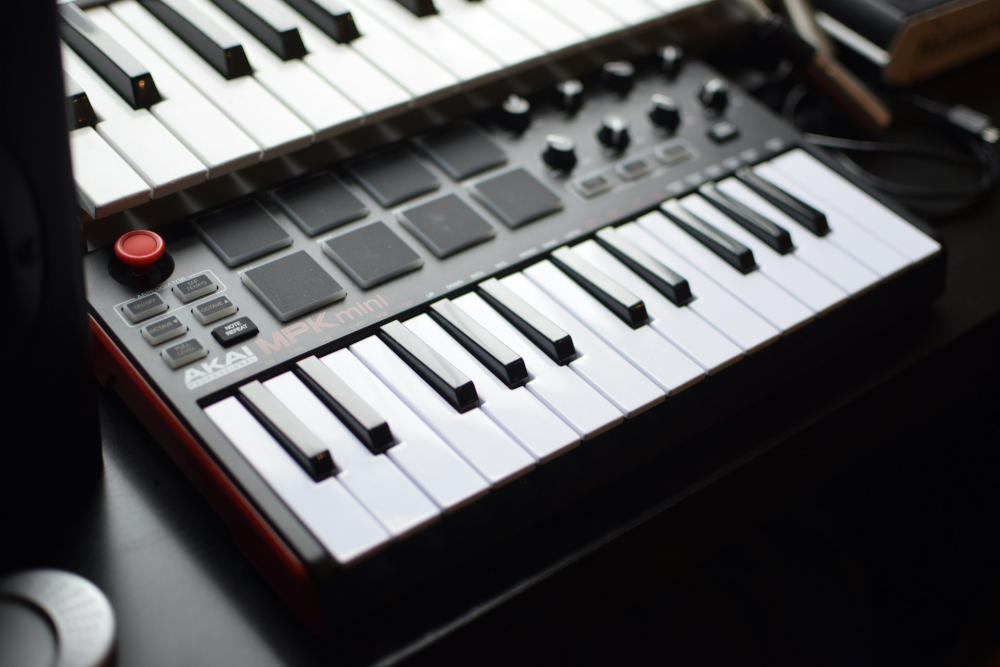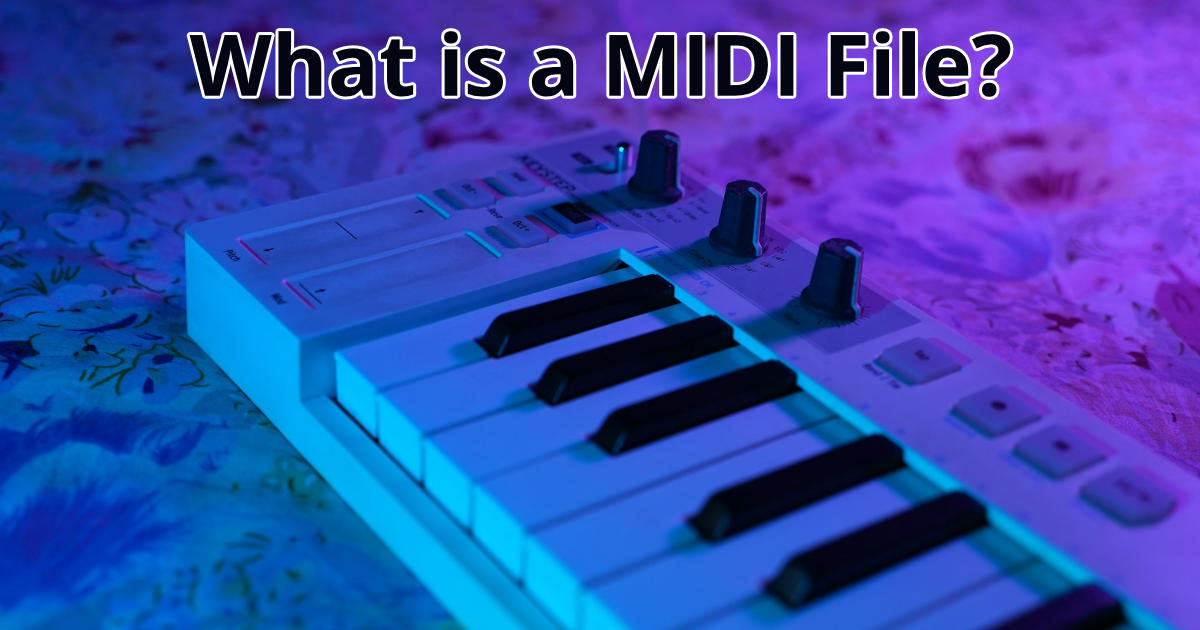Estimated reading time: 7 minutes
Ever stumbled upon a file with a “.midi” extension and wondered what magic lies within? I sure did. MIDI files, or Musical Instrument Digital Interface files, are the unsung heroes of the music technology world. They pack a punch, allowing musicians and producers to create, edit, and play back music with a level of flexibility that’s hard to beat. But what exactly is a MIDI file? Let’s embark on this journey to unravel the mystery together.
Table of contents
- What is a MIDI file?
- The History of MIDI: MIDI 1.0 vs MIDI 2.0
- Understanding the MIDI Format: Sequential Circuits
- MIDI vs Other Audio Formats: MP3 File and More
- Inside a MIDI File: Exploring Musical Notes, MIDI Channel, and Status Bytes
- The Role of MIDI in Digital Audio Workstations
- MIDI Playback: From Electronic Instrument to Controller Keyboard
- The Process: How to Make a MIDI File
- The Practical Guide: How to Use a MIDI Keyboard
- Exploring MIDI Melodies: The Wide Variety of Internal and Additional Sounds
- Conclusion: Unraveling the MIDI Mystery
- FAQs
What is a MIDI file?
A MIDI file is like a digital score. Instead of containing actual audio, it stores instructions for playing music. These instructions include which notes to play, their duration, and intensity, along with other performance data. Imagine you’re a conductor, and the MIDI file is your baton – it tells the orchestra (in this case, electronic instruments) exactly what to do. It’s a powerful tool for musicians, allowing for intricate compositions and arrangements without recording actual audio.
The History of MIDI: MIDI 1.0 vs MIDI 2.0
MIDI isn’t a new kid on the block. It’s been around since the early 1980s, with the first standard, MIDI 1.0, introduced in 1983. This was revolutionary, enabling synths from different manufacturers to communicate. Fast forward to the present, and we have MIDI 2.0, which brings enhanced expressiveness, higher resolution for controllers, and better compatibility. The leap from MIDI 1.0 to 2.0 is like moving from a flip phone to a smartphone – the core function remains, but the capabilities are vastly expanded.
| Aspect | MIDI 1.0 | MIDI 2.0 |
|---|---|---|
| Introduction | Introduced in 1983 | Introduced in 2020 |
| Revolutionized | Synth communication | Enhanced expressiveness |
| Resolution | Standardized communication | Higher resolution for controllers |
| Compatibility | Enabled communication between different synths | Better compatibility with modern devices and software |
| Core Function | Communication protocol for musical instruments | Expanded capabilities without changing core functionality |
Understanding the MIDI Format: Sequential Circuits
Diving deeper into the MIDI world, it’s fascinating to see how it works. Sequential circuits, a key concept in MIDI, refer to the order in which musical events are executed. This ensures that notes are played in the correct sequence, maintaining the intended rhythm and melody. It’s like reading a book; you need to follow the words in order to understand the story. Sequential circuits ensure that the story of your music is told exactly as you envisioned it.

MIDI vs Other Audio Formats: MP3 File and More
When comparing MIDI files to other audio formats like MP3, the difference is stark. While MP3 files contain compressed audio data (actual sounds), MIDI files do not store audio. They store performance data (notes, rhythms, etc.), making them incredibly versatile and lightweight. This means you can tweak individual notes, change instruments, and adjust tempo without affecting audio quality – something you can’t do with an MP3.
| Aspect | MIDI File | MP3 File |
|---|---|---|
| Content | Performance data (notes, rhythms, etc.) | Compressed audio data (actual sounds) |
| Editing | Allows for tweaking individual notes, changing instruments, tempo | Editing affects audio quality; limited manipulation |
| Versatility | Highly versatile; lightweight | Less versatile; larger file size |
| Quality | No loss of quality during editing | Quality can degrade with repeated editing or compression |
| Use Cases | Ideal for composition, arranging, editing | Primarily for playback; limited editing capabilities |
Inside a MIDI File: Exploring Musical Notes, MIDI Channel, and Status Bytes
Peeking inside a MIDI file reveals a world of musical notes, channels, and status bytes. Each note in a MIDI file is associated with specific information – not just pitch, but velocity (how hard the note is played) and duration. MIDI channels, numbering up to 16, allow for multiple instruments to be controlled simultaneously. Status bytes, meanwhile, communicate the type of message being sent (note on, note off, etc.), ensuring everything is in perfect harmony.
| Aspect | Description |
|---|---|
| Musical Notes | Contains information on pitch, velocity (how hard the note is played), and duration of each note. |
| MIDI Channel | Divides MIDI data into 16 channels, allowing for simultaneous control of multiple instruments. |
| Status Bytes | Communicate the type of message being sent (e.g., note on, note off), ensuring proper data interpretation. |
The Role of MIDI in Digital Audio Workstations
In the realm of Digital Audio Workstations (DAWs), MIDI is indispensable. It allows for detailed editing of individual notes and rhythms, making it a favorite tool for composers and producers. Whether you’re fine-tuning a complex drum pattern or orchestrating a symphony, MIDI gives you the control you need to realize your musical vision precisely.

MIDI Playback: From Electronic Instrument to Controller Keyboard
MIDI playback can transform a simple electronic instrument into a full orchestra or band. With a controller keyboard, you can trigger a wide variety of internal and additional sounds, from pianos and strings to synths and drums. This versatility makes MIDI an essential tool for live performances and studio work alike, allowing musicians to express themselves in countless ways.
The Process: How to Make a MIDI File
Making a MIDI file might sound daunting, but it’s quite accessible. You start with a MIDI-compatible instrument or software, lay down your notes, and edit as needed. It’s a bit like sculpting – you begin with a block of marble (your initial idea) and chisel away (edit) until you reveal the statue within (your final MIDI composition). The beauty of MIDI is that you can always tweak and adjust until everything is just right.

The Practical Guide: How to Use a MIDI Keyboard
Using a MIDI keyboard opens up a world of musical possibilities. It’s not just a piano; it’s a controller that can command an array of virtual instruments. By connecting it to a computer or sound module, you can explore different sounds, layer textures, and even control lighting or visuals during a live performance. The key is experimentation – the more you play, the more you discover.
Exploring MIDI Melodies: The Wide Variety of Internal and Additional Sounds
One of the joys of working with MIDI Melodies is the sheer variety of sounds at your disposal. From the authentic reproduction of acoustic instruments to the creation of entirely new sounds, MIDI allows you to explore musical territories that would otherwise be inaccessible. Whether you’re layering lush string sections or dialing in the perfect synth lead, MIDI gives you the palette to paint your sonic masterpiece.
Conclusion: Unraveling the MIDI Mystery
We’ve journeyed through the world of MIDI files, from their history and format to their indispensable role in music production and performance. Understanding what a MIDI file is and how it works demystifies this powerful tool, opening up endless creative possibilities. Whether you’re a seasoned producer or just starting out, embracing the world of MIDI can transform your musical creations.
While this article provides an overview, the world of MIDI is vast and endlessly fascinating. As technology advances, who knows what new capabilities we’ll see? For now, dive in, experiment, and let MIDI expand your musical horizons.
Related Posts
- What is Mastering? The Final Touch in Music Production
- What is a Masterclass? The Ultimate Online Learning Experience for Music Producers
- How to Connect a MIDI Keyboard to FL Studio
- How to import MIDI files?
- What Does Quantize Mean in Music – Unlocking the Rhythm
- What is Quantization in Music? Unraveling the Mystery
- What is a Reese Bass? Unraveling the Mystery
- What Makes a Good Song? Unlocking the Mysteries of Memorable Music
- What is an Interlude in an Album? Unraveling the Musical Magic Between Tracks
FAQs
No, MIDI files contain performance data, not actual audio.
While there are tools that claim to convert audio files to MIDI, the results vary greatly and often require significant editing.
Absolutely. Its versatility and control make it indispensable for composers and producers.
Yes, but you’ll need a software player or DAW that can interpret MIDI data and use virtual instruments for playback.
Yes, the most common are Type 0 (single track) and Type 1 (multiple tracks) standard MIDI files.
